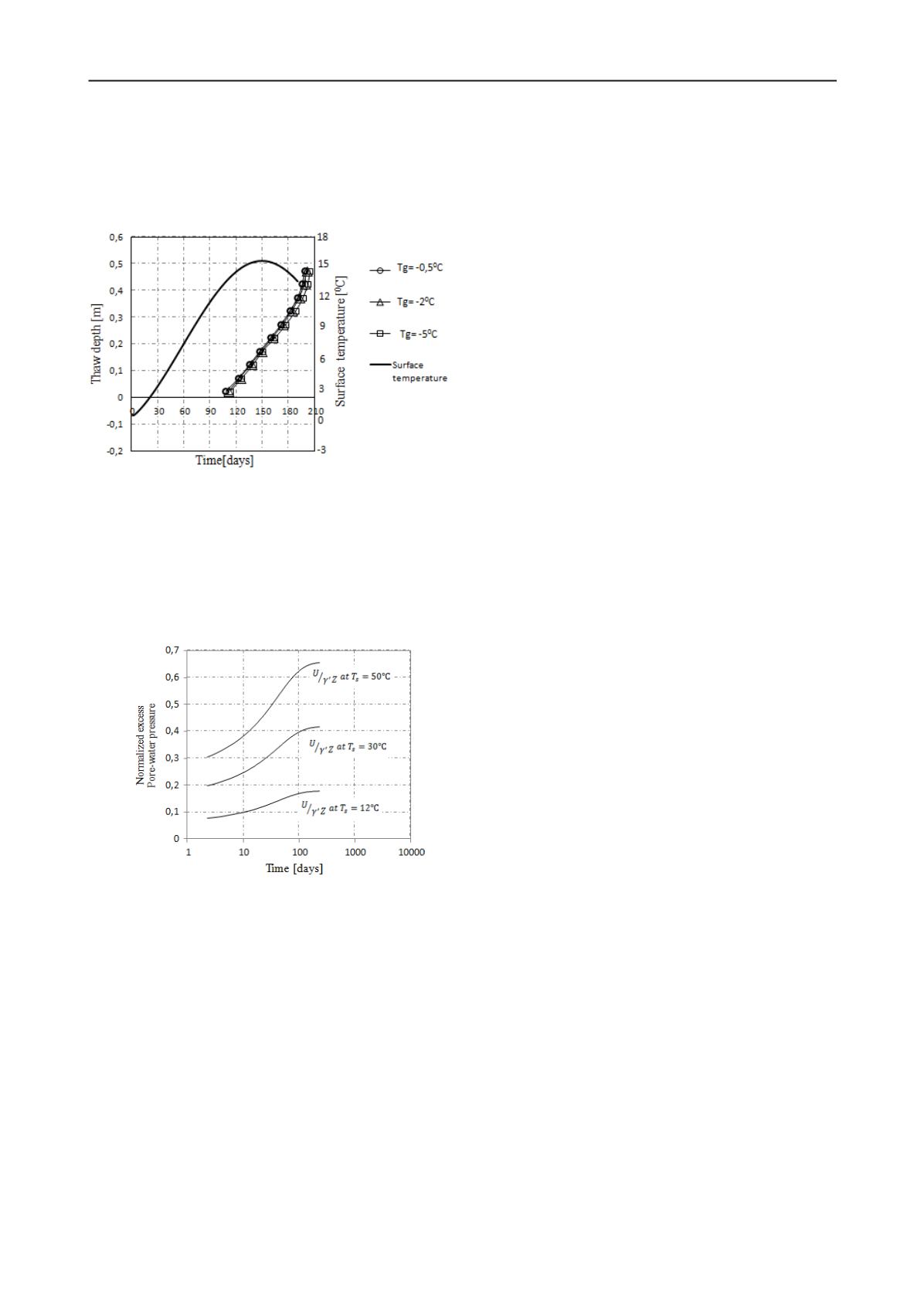
860
Proceedings of the 18
th
International Conference on Soil Mechanics and Geotechnical Engineering, Paris 2013
Proceedings of the 18
th
International Conference on Soil Mechanics and Geotechnical Engineering, Paris 2013
proportional to the square root of time of thawing. Based on the
results from the FEM analysis, when sinusoidal surface
temperature and thermal properties of pavement layers such as
asphalt and base layers are considered, the thawing depth can be
directly proportional to the rate time (see Figure 5).
Figure 5: Thawing rate in frozen subgrade under a pavement.
An average of 110 days is required for the frozen layer to
start thawing for the given thermal properties and boundary
conditions assumed in this analysis. No significant difference is
observed for the variation of the initial ground temperature on
the thaw rate. Constant rate of thawing in subgrades(in terms of
mm/day) has been observed in different field tests reported in
Doré (2004).
Figure 6: Excess pore pressure at soil-ice interface for a constant
surface temperature. The curves are based on the analytical solution of
Nixon(1973).
It can be observed (in Figure 6) from analytical solution of
Nixon(1973) that the time required for the development of
maximum excess pore water pressure at the soil-ice interface
(thawing period) is the same regardless of the temperature
gradient . In the contrary, the maximum excess pore water
pressure generated when the surface temperature is 30
℃
, is
twice the maximum excess pore pressure generated at a constant
surface temperature of 10
℃
. This comparison is only for self-
weight loading of the soil and the expected excess pore water
pressure can be very high depending on the overburden pressure
from the pavements and traffic loading.
3 CONCLUSION
In the previous analytical methods of thaw depth calculations,
the Stephan’s method is commonly used and the thaw depth is
assumed to be proportional to the square root of the thawing
time. This assumption is valid for constant surface temperature.
The numerical simulation based on a sinusoidal surface
temperature has shown that for the case of frozen layers in
pavements, a constant rate of thawing is obtained. A higher
thawing rate in less permeable frozen soils results in high excess
pore water pressure. The late spring thawing can be predicted
from the change in pavement temperature from available
climatic data, and thermal and physical properties of the
pavement materials. This has a significant importance in road
design and maintenance planning in cold climate regions. The
development of excess pore water pressure highly depends on
the temperature distribution in the pavement layers and traffic
load and initial states. The excess pore water pressure
development is also largely dependent on the physical
properties of the thawed soil such as the coefficient of
consolidation and permeability.
4
ACKNOWLEDGEMENTS
The research is carried out at the Norwegian University of
Science and Technology (NTNU) with the financial support
from the Norwegian Public Roads Administration.
5 REFERENCES
Abaqus FEA, D S Simulia. 2011 Dassault Systèmes.
Andersland, O.B. and Ladanyi, B. 2004. Frozen Ground Engineering.
2nd ed. The American Society of Civil Engineers and John Wiley
& Sons, Inc.
Becker, B.R., Misra, A. and Fricke, B.A. 1992. Development of
Correlations for Soil Thermal Conductivity.
International
Communications in Heat and Mass Transfer
, 19(1), 59-68.
Carslaw, H.S. and J.C. Jaeger 1959. Conduction of Heat in Solids. 2nd
ed. Oxford University Press.
Berntsen, G. 1993. Reduction of bearing capacity during thawing(in
Norwegian), Norwegian Institute of Technology: Trondheim,
Norway.
Doré, G. 2004. Development and validation of the thaw-weakening
index.
International Journal of Pavement Engineering
,.
5
(4), 185-
192.
Harlan, R.L. 1973. Analysis of Coupled Heat - Fluid Transport in
Partially Frozen Soil. Water Resources Research,
9
(5), 1314-1323.
Janbu, N. 1970. Grunnlag i geoteknikk(in Norwegian)., Trondheim:
Tapir Forlag.
Johnson, T.C., R.L. Berg, E.J. Chamberlain,D.M. Cole. 1986. Frost
Action Predictive Techniques for Roads and Airfields: A
Comprehensive Survey of Research Findings.
Cold Regions
Research and Engineering Laboratory CRREL report 86-18.
Morgenstern, N.R. and Nixon, J.F. 1971. One-dimensional
consolidation of thawing soils.
Canadian Geotechnical Journal
,
8(4), 558-565.
Nixon, J.F. 1973. Thaw-Consolidation of Some Layered Systems.
Canadian Geotechnical Journal
, 10(4), 617-631.
Nixon, J.F. and McRoberts, E.C. 1973. A study of some factors
affecting the thawing of frozen soils.
Canadian Geotechnical
Journal
, 10(3), 439-452.
NPRA. 2011. Håndbok 018: Road construction standards (in
Norwegian). Norwegian Public Roads Adminstration.
Nordal, R.S. and Hansen, E.K. 1987. The Vormsund Test Road, Part 4:
Summary report, Norwegian Road Research Laboratory.
Penner, E. 1970. Thermal Conductivity of Frozen Soils.
Canadian
Journal of Earth Science
, 7(3), 982-987.
Penner, E., Johnston, G.H. and Goodrich, L.E. 1975. Thermal
Conductivity Laboratory Studies of Some Mackenzie Highway
Soils
. Canadian Geotechnical Journal
, 12(3), 271-288.
Simonsen, E. and Isacsson, U. 1999. Thaw weakening of pavement
structures in cold regions.
Cold Regions Science and Technology
,
29(2), 135-151.
Xu, J., Abdella, B., Eltaher, A., and Jukes, P. 2009. Permafrost Thawing
- Pipeline Interaction Advanced Finite Element Model. in
Proceedings of the ASME 2009 28th International Conference on
Ocean, Offshore and Arctic Engineerin
g, OMAE2009. Honolulu,
Hawaii, USA, 1-6.


